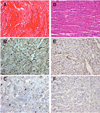Cardiac xenotransplantation: progress and challenges
- PMID: 22327911
- PMCID: PMC3326642
- DOI: 10.1097/MOT.0b013e3283509120
Cardiac xenotransplantation: progress and challenges
Abstract
Purpose of review: Cardiac xenotransplantation (CXTx) remains a promising approach to alleviate the chronic shortage of donor hearts. This review summarizes recent results of heterotopic and orthotopic CXTx, highlights the role of non-Gal antibody in xenograft rejection, and discusses challenges to clinical orthotopic CXTx.
Recent findings: Pigs mutated in the α 1,3 galactosyltransferase gene (GTKO pigs) are devoid of the galactose α1,3 galactose (αGal) carbohydrate antigen. This situation effectively eliminates any role for anti-Gal antibody in GTKO cardiac xenograft rejection. Survival of heterotopic GTKO cardiac xenografts in nonhuman primates continues to increase. GTKO graft rejection commonly involves vascular antibody deposition and variable complement deposition. Non-Gal antibody responses to porcine antigens associated with inflammation, complement, and hemostatic regulation and to new carbohydrate antigens have been identified. Their contribution to rejection remains under investigation. Orthotopic CXTx is limited by early perioperative cardiac xenograft dysfunction (PCXD). However, hearts affected by PCXD recover full cardiac function and orthotopic survival up to 2 months without rejection has been reported.
Summary: CXTx remains a promising technology for treating end-stage cardiac failure. Genetic modification of the donor and refinement of immunosuppressive regimens have extended heterotopic cardiac xenograft survival from minutes to in excess of 8 months.
Conflict of interest statement
There are no conflicts of interest to report.
Figures



References
-
- Atala A, Bauer SB, Soker S, Yoo JJ, Retik AB. Tissue-engineered autologous bladders for patients needing cystoplasty. Lancet. 2006 Apr 15;367(9518):1241–1246. - PubMed
-
- Ott HC, Matthiesen TS, Goh SK, et al. Perfusion-decellularized matrix: using nature's platform to engineer a bioartificial heart. Nat Med. 2008 Feb;14(2):213–221. - PubMed
-
- McGregor CG, Davies WR, Oi K, et al. Cardiac xenotransplantation: recent preclinical progress with 3-month median survival. J Thorac Cardiovasc Surg. 2005 Sep;130(3):844–851. - PubMed
Publication types
MeSH terms
Substances
Grants and funding
LinkOut - more resources
Full Text Sources
Other Literature Sources
Medical
Research Materials

